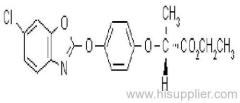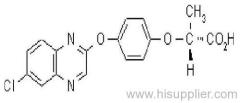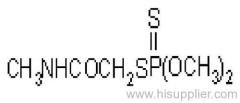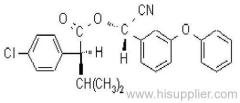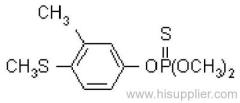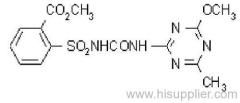
|
Shanghai Skyblue Chemical Co., Ltd.
|
Azamethiphos
| Place of Origin: | Shanghai, China (Mainland) |
|
|
|
| Add to My Favorites | |
| HiSupplier Escrow |
Product Detail
Insecticide with contact and stomach action. Gives rapid knockdown, and has good residual activity.
Common name: azamethiphos
IUPAC name: S-6-chloro-2,3-dihydro-2-oxo-1,3-oxazolo[4,5-b]pyridin-3-ylmethyl O,O-dimethyl phosphorothioate; 6-chloro-3-dimethoxyphosphinoylthiomethyl-1,3-oxazolo[4,5-b]pyridin-2(3H)-one
Chemical Abstracts name: S-[(6-chloro-2-oxooxazolo[4,5-b]pyridin-3(2H)-yl)methyl] O,O-dimethyl phosphorothioate
CAS RN: [35575-96-3]
EEC no.: 252-626-0
PHYSICAL CHEMISTRY
Composition: Tech. is >95%. Mol. wt.: 324.7; M.f.: C9H10ClN2O5PS; Form: Colourless crystals; (tech. is a beige to grey powder). M.p.: 89 ºC. V.p.: 0.0049 mPa (20 ºC). KOW: logP = 1.05; Henry: 1.45x10-6 Pa m3 mol-1 (calc.) S.g./density: 1.60 (20 ºC). Solubility: In water 1.1 g/l (pH 7, 20 ºC). In dichloromethane 610, benzene 130, methanol 100, n-octanol 5.8 (all in g/kg, 20 ºC). Stability: Unstable in acids and alkalis; DT50 (20 ºC) (calc.): 800 h (pH 5), 260 h (pH 7), 4.3 h (pH 9). F.p.: >150 °C (Marcusson, without stirring).
APPLICATIONS
Biochemistry: Cholinesterase inhibitor.
Mode of action: Insecticide with contact and stomach action. Gives rapid knockdown, and has good residual activity.
Uses: Control of flies and other insect pests in animal houses. Control of mosquitoes, tsetse flies, cockroaches, and other public hygiene pests.
Formulation types: AE; WP.
MAMMALIAN TOXICOLOGY
Oral: Acute oral LD50 for rats 1180 mg/kg.
Skin and eye: Acute percutaneous LD50 for rats >2150 mg/kg. Mild eye irritant; non-irritating to skin (rabbits).
Inhalation: LC50 (4 h) for rats >560 mg/m3 air.
NOEL: (90 d) for rats 20 mg/kg diet (2 mg/kg daily), for dogs 10 mg/kg diet (0.3 mg/kg daily).
ADI: 0.025 mg/kg.
Toxicity class: WHO (a.i.) III; EPA (formulation) III
ECOTOXICOLOGY
Birds: Acute oral LD50 for bobwhite quail 30.2, mallard ducks 48.4 mg/kg. Dietary LC50 (8 d) for bobwhite quail 860, Japanese quail >1000, mallard ducks 700 ppm. Based on the results of acute laboratory trials, azamethiphos is classified as highly toxic to birds. However, sublethal doses have a repellent effect on birds, so the risk for birds is significantly reduced.
Fish: LC50 (96 h) for channel catfish 3, crucian carp 6, guppy 8, rainbow trout 0.115-0.2, sheepshead minnow 2.22 mg/l. Based on the test with the most sensitive species, rainbow trout, azamethiphos is classified as highly toxic to fish. All other test species were less sensitive to this compound.
Daphnia: LC50 (48 h) 0.67 ug/l.
Bees: Toxic to bees; LD50 (24 h) (oral) <0.1 ug/bee; (contact) 10 ug/bee.
ENVIRONMENTAL FATE
Animals: In rats and goats, the glucuronic acid conjugate of 2-amino-3-hydroxy-5-chloropyridine represents the major metabolite, accounting for 27-48% of the dose, followed by the corresponding sulfuric acid conjugate accounting for 3-20% of the dose.
Soil/Environment: In loamy sand (aerobic), DT50 c. 6 h.




